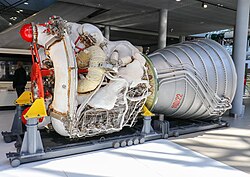 Model of RD-0120 | |
| Country of origin | Soviet Union |
|---|---|
| Date | 1976-1987 |
| First flight | 1987-05-15 |
| Last flight | 1988-11-15 |
| Designer | OKB-154 |
| Manufacturer | Voronezh Mechanical Plant |
| Application | Sustainer engine |
| Associated LV | Energia |
| Successor | RD-0122 |
| Status | Retired |
| Liquid-fuel engine | |
| Propellant | LOX / LH2 |
| Mixture ratio | 6.0 |
| Cycle | Staged сombustion |
| Configuration | |
| Chamber | 1 |
| Nozzle ratio | 85.70 |
| Performance | |
| Thrust, vacuum | 1,961.3 kN (440,900 lbf), 106% |
| Thrust, sea-level | 1,526 kN (343,000 lbf), 106% |
| Thrust-to-weight ratio | 57.93, vac., 106% thrust |
| Chamber pressure | 21.9 MPa (3,180 psi) |
| Specific impulse, vacuum | 455 s (4.46 km/s) |
| Specific impulse, sea-level | 353.2 s (3.464 km/s) |
| Burn time | 500 s |
| Gimbal range | ±7° |
| Dimensions | |
| Length | 4,550 mm (179 in) |
| Diameter | 2,420 mm (95 in) |
| Dry mass | 3,450 kg (7,610 lb) |
| Used in | |
| Energia core stage | |
| References | |
| References | [1][2][3][4] |
The RD-0120 (Russian: Ракетный Двигатель-0120, romanized: Raketnyy Dvigatel-0120, lit. 'Rocket Engine 0120', GRAU index: 11D122) was the Energia core rocket engine, fueled by LH2/LOX, roughly equivalent to the Space Shuttle Main Engine (SSME). These were attached to the Energia core rather than the orbiter, so were not recoverable after a flight, but created a more modular design (the Energia core could be used for a variety of missions besides launching the shuttle). The RD-0120 and the SSME have both similarities and differences. The RD-0120 achieved a slightly higher specific impulse and combustion chamber pressure with reduced complexity and cost (but it was single-use), as compared to the SSME. It uses a fuel-rich staged combustion cycle and a single shaft to drive both the fuel and oxidizer turbopumps. Some of the Russian design features, such as the simpler and cheaper channel wall nozzles, were evaluated by Rocketdyne for possible upgrades to the SSME. It achieved combustion stability without the acoustic resonance chambers that the SSME required.
Specifications
[edit]RD-0120
[edit]- Thrust (vacuum): 1.8639 MN (190 tons), (sea-level): 1.5171 MN
- Specific impulse (vacuum): 454 seconds (4.45 km/s), (sea-level): 359 seconds (3.52 km/s)
- Burn time: nominal 480–500 s, certified for 1670 s
- Basic engine weight: 3,449 kg
- Length: 4.55 m, diameter: 2.42 m
- Propellants: LOX & LH2
- Mixture ratio: 6:1
- Contractor: Chemical Automatics Design Bureau (Конструкторское Бюро Химавтоматики)
- Vehicle application: Energia core stage.
See also
[edit]References
[edit]- ^ "RD-0120". Encyclopedia Astronautica. Archived from the original on December 3, 2007. Retrieved July 15, 2015.
- ^ "ЖРД РД-0120 (11Д122)" [RD-0120 (11D122)] (in Russian). Retrieved July 7, 2015.
- ^ "Liquid Rocket Engine". Voronezh Mechanical Plant. Archived from the original on July 9, 2015. Retrieved May 29, 2015.
- ^ Hendrickx, Bart; Bert, Vis (2007). Energiya-Buran: The Soviet Space Shuttle. Chichester, UK: Praxis Publishing Ltd. ISBN 978-0-387-69848-9.
